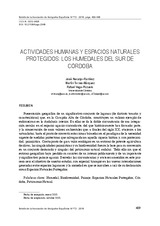Mostrar el registro sencillo del ítem
Actividades humanas y espacios naturales protegidos: los humedales del sur de Córdoba
| dc.contributor.author | Naranjo-Ramírez, J. | |
| dc.contributor.author | Torres-Márquez, Martín | |
| dc.contributor.author | Vega-Pozuelo, Rafael | |
| dc.date.accessioned | 2016-12-12T08:49:30Z | |
| dc.date.available | 2016-12-12T08:49:30Z | |
| dc.date.issued | 2016 | |
| dc.identifier.uri | http://hdl.handle.net/10396/14150 | |
| dc.description.abstract | Presentación geográfica de un significativo conjunto de lagunas (de distinto tamaño y características) que, en la Campiña Alta de Córdoba, constituyen un valioso ejemplo de endorreísmo en la Andalucía interior. En ellas se da la doble circunstancia de una integra - ción secular en el espacio agrario circundante, del que históricamente han formado parte, y la conservación de unos valores ambientales que, a finales del siglo XX, atrajeron a los naturalistas, hasta el punto de convertir estas zonas húmedas en el paradigma de la necesidad urgente de medidas protectoras que salvaguardaran aquella riqueza biótica y, con posteriori - dad, paisajística. Contrapunto de gran valor ecológico en un entorno de potente agricultura de olivar, las singularidades paisajísticas y su biodiversidad fueron la base para su conversión en un conjunto destacado y singular del patrimonio natural andaluz. Todo ello sin que el entorno geográfico haya perdido su carácter de un intenso poblamiento y de un importante y significativo paisaje agrario. Desvelar las circunstancias y avatares acaecidos en este pro - ceso será el objetivo de nuestro estudio, con especial hincapié en las nuevas interrelaciones generadas entre espacios lagunares y la sociedad en que se inscriben a raíz de su declaración como Espacios Naturales Protegidos. | es_ES |
| dc.description.abstract | The wetlands in Southern Cordoba are the geographical presentation of a meaningful group of lakes (with different sizes and features) that, in the Campiña Alta, constitute a valuable example of endorreism in inner Andalusia. They reunite an ancient integration within the surrounding agricultural areas, from which they have been historically part of, and the preservation of a set of environmental values that, at the end of the 20th century, attracted naturalists to the point of turning these wetlands into the epitome of the urgent need to pass protecting measures to shield that biotic wealth and, later, landscape richness. As a powerful environmentaly valuable counterpart of the mighty olive grove agriculture surroundings, the landscape singularities and its biodiversity were the ground for their turning into an outstanding and unique part of the natural Andalusian heritage. All without the loss of the dense settlement and the important and meaningful agrarian landscape, typical from this geographical setting. The goal of our study will be to unravel the circumstances and vicissitudes that took place during this process, paying special attention to the new interrelations created within the wetlands and the society they are part of since their proclamation as Natural Protected Areas. | es_ES |
| dc.format.mimetype | application/pdf | es_ES |
| dc.language.iso | spa | es_ES |
| dc.publisher | Asociación de Geógrafos Españoles | es_ES |
| dc.rights | https://creativecommons.org/licenses/by-nc-nd/4.0/ | es_ES |
| dc.source | Boletín de la Asociación de Geógrafos Españoles 72, 409-446 (2016) | es_ES |
| dc.subject | Humedales | es_ES |
| dc.subject | Biodiversidad | es_ES |
| dc.subject | Paisaje | es_ES |
| dc.subject | Espacios naturales protegidos | es_ES |
| dc.subject | Córdoba (España) | es_ES |
| dc.subject | Patrimonio natural | es_ES |
| dc.subject | Wetlands | es_ES |
| dc.subject | Biodiversity | es_ES |
| dc.subject | Landscape | es_ES |
| dc.subject | Natural protected areas | es_ES |
| dc.subject | Heritage | es_ES |
| dc.title | Actividades humanas y espacios naturales protegidos: los humedales del sur de Córdoba | es_ES |
| dc.type | info:eu-repo/semantics/article | es_ES |
| dc.rights.accessRights | info:eu-repo/semantics/openAccess | es_ES |

